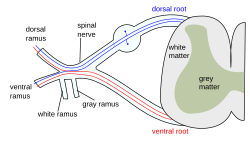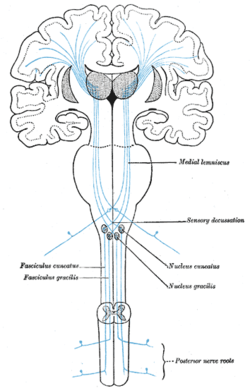Posterior column–medial lemniscus pathway
| Posterior column-medial lemniscus pathway | |
|---|---|

The formation of the spinal nerve from the dorsal and ventral roots.
|
|

Originating in peripheral sensory receptors, the posterior column-medial lemniscus pathway transmits fine touch and conscious proprioceptive information to the brain.
|
|
| Details | |
| Precursor | Neural tube and crest |
| System | Somatosensory system |
| Latin | via columnae posterioris lemniscique medialis |
|
Anatomical terminology
[]
|
|
Posterior column–medial lemniscus pathway (PCML) (also known as the dorsal column-medial lemniscus pathway DCML) is a sensory pathway of the central nervous system that conveys localized sensations of fine touch, vibration, two-point discrimination, and proprioception (position sense) from the skin and joints. It transmits information from the body to the postcentral gyrus of the cerebral cortex.
There are three neurons involved in the pathway: first-order neurons, second-order neurons, and third-order neurons. The first-order neurons reside in dorsal root ganglia and send their axons through the gracile fasciculus and cuneate fasciculus. The first-order axons make contact with second order neurons at the gracile and cuneate nuclei in the lower medulla. The second-order neurons send their axons to the thalamus. The third order neurons arise from thalamus to the postcentral gyrus.
The posterior column is composed of gracile fasciculus and cuneate fasciculus. The gracile fasciculus carries input from the lower half of the body and the cuneate fasciculus carries input from the upper half of the body. The gracile fasciculus arise from the fibers more medial than the cuneate fasciculus.
When the axons of second-order neurons of the PCML decussate in the medulla, they are called internal arcuate fibers. The crossings of the internal arcuate fibers form the medial lemniscus.
The name comes from the two structures that the sensation travels up: the posterior (or dorsal) column of the spinal cord, and the medial lemniscus in the brainstem.
...
Wikipedia
